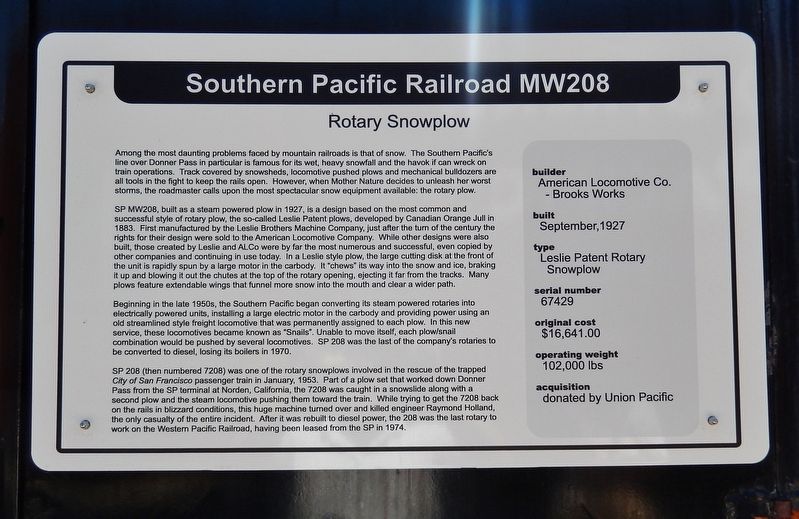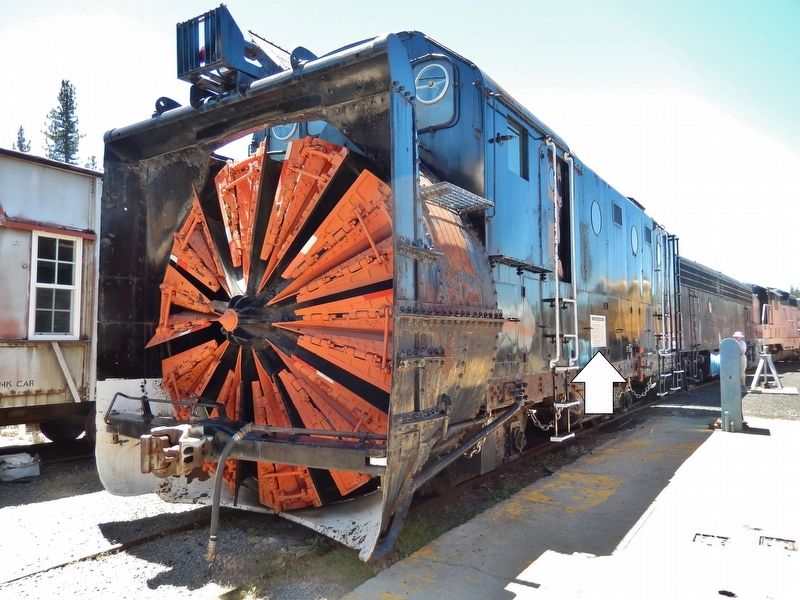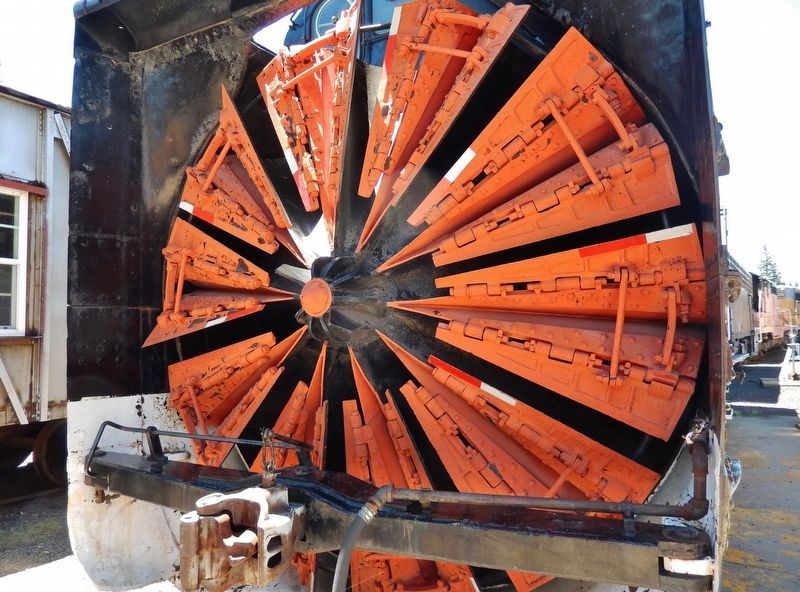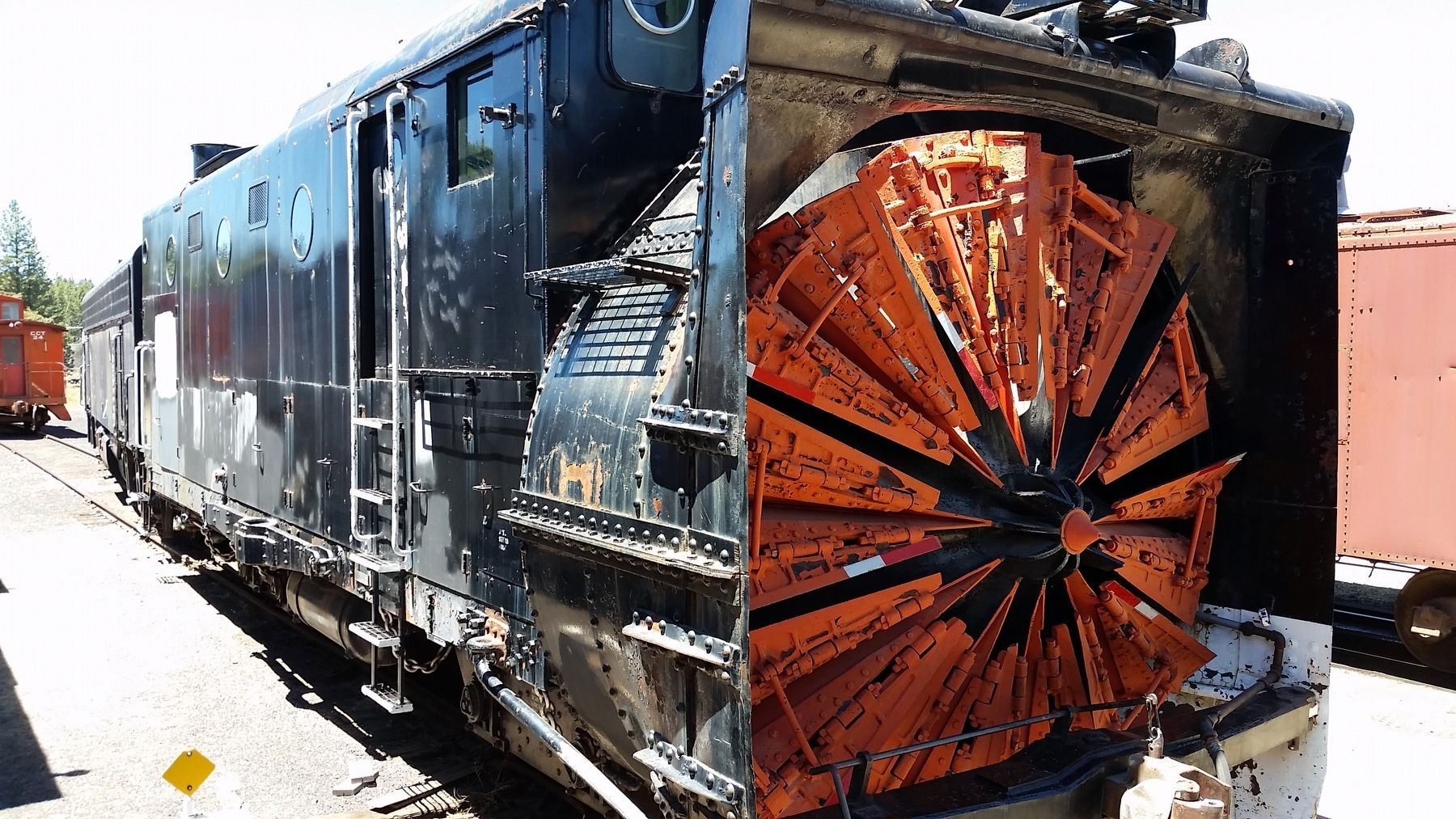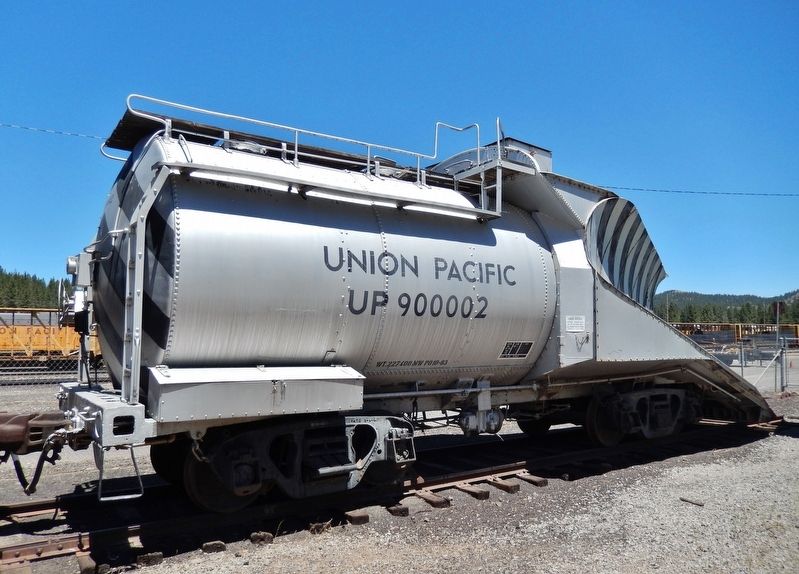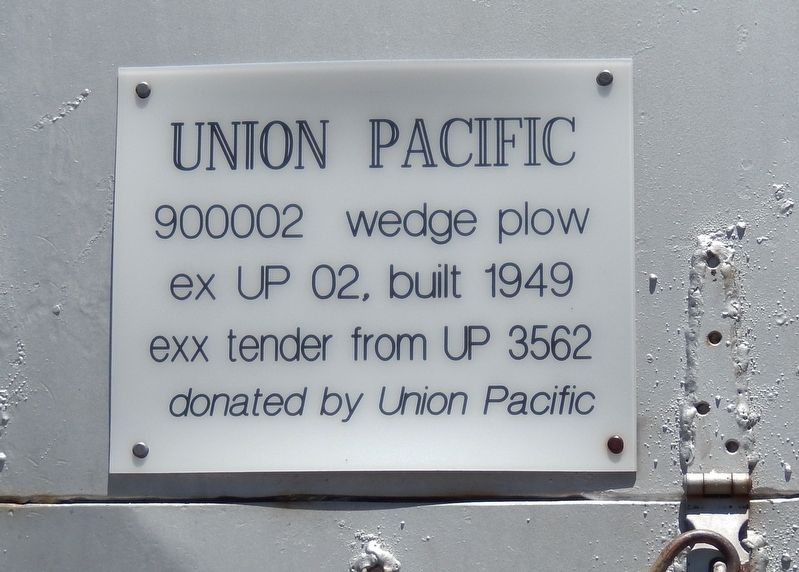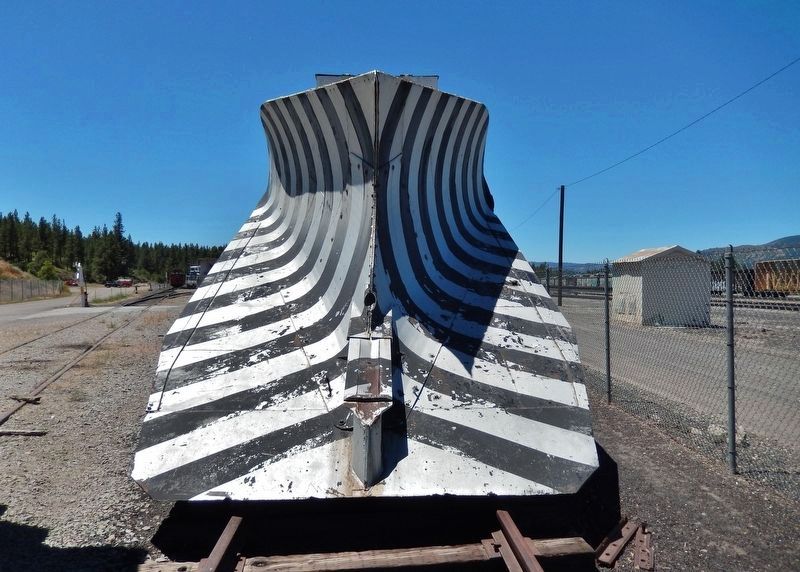Portola in Plumas County, California — The American West (Pacific Coastal)
Southern Pacific Railroad MW208
Rotary Snowplow
SP MW208, built as a steam powered plow in 1927, is a design based on the most common and successful style of rotary plow, the so-called Leslie Patent plows, developed by Canadian Orange Jull in 1883. First manufactured by the Leslie Brothers Machine Company, just after the turn of the century the rights for their design were sold to the American Locomotive Company. While other designs were also built, those created by Leslie and ALCo were by far the most numerous and successful, even copied by other companies and continuing in use today. In a Leslie style plow, the large cutting disk at the front of the unit is rapidly spun by a large motor in the carbody. It "chews" its way into the snow and ice, braking it up and blowing it out the chutes at the top of the rotary opening, ejecting it far from the tracks. Many plows feature extendable wings that funnel more snow into the mouth and clear a wider path.
Beginning in the late 1950s, the Southern Pacific began converting its steam powered rotaries into electrically powered units, installing a large electric motor in the carbody and providing power using an old streamlined style freight locomotive that was permanently assigned to each plow. In this new service, these locomotives became known as "Snails". Unable to move itself, each plow/snail combination would be pushed by several locomotives. SP 208 was the last of the company's rotaries to be converted to diesel, losing its boilers in 1970.
SP 208 (then numbered 7208) was one of the rotary snowplows involved in the rescue of the trapped City of San Francisco passenger train in January, 1953. Part of a plow set that worked down Donner Pass from the SP terminal at Norden, California, the 7208 was caught in a snowslide along with a second plow and the steam locomotive pushing them toward the train. While trying to get the 7208 back on the rails in blizzard conditions, this huge machine turned over and killed engineer Raymond Holland, the only casualty of the entire incident. After it was rebuilt to diesel power, the 208 was the last rotary to work on the Western Pacific Railroad, having been leased from the SP in 1974.
builder • American Locomotive Co. - Brooks Works
built
• September, 1927
type • Leslie Patent Rotary Snowplow
serial number • 67429
original cost • $16,641.00
operating weight • 102,000 lbs
acquisition • donated by Union Pacific
Erected by Western Pacific Railroad Museum.
Topics. This historical marker is listed in this topic list: Railroads & Streetcars. A significant historical month for this entry is September 1927.
Location. 39° 48.212′ N, 120° 28.583′ W. Marker is in Portola, California, in Plumas County. Marker can be reached from Western Pacific Way, ¼ mile west of Main Street. Marker is mounted directly on the subject snowplow, on exhibit in the Western Pacific Railroad Museum yard. Touch for map. Marker is at or near this postal address: 700 Western Pacific Way, Portola CA 96122, United States of America. Touch for directions.
Other nearby markers. At least 8 other markers are within walking distance of this marker. Western Pacific Railroad 501 (a few steps from this marker); Western Pacific 106 "Charles O. Sweetwood" (a few steps from this marker); Union Pacific Railroad 6946 (within shouting distance of this marker); Western Pacific Railroad 6424 (within shouting distance of this marker); Western Pacific Railroad 484 (within shouting distance of this marker); Central California Traction Company 24 (within shouting distance of this marker); Railroad Rail (within shouting distance of this marker); Western Pacific Railroad History (within shouting distance of this marker). Touch for a list and map of all markers in Portola.
Also see . . .
1. SP MW208 & SP MW8221 Rotary Snow Plow & Snail. For a variety of reasons, MW208 was loaned to other railroads in the late 1960s and early 70s, including 10 days in northern Arizona on the Santa Fe Railway in December 1967 and some used on the McCloud River Railway. (Submitted on December 27, 2020, by Cosmos Mariner of Cape Canaveral, Florida.)
2. SP Rotary Snow Plow Throwing Snow. (youtube video of SP Rotary Snow Plow Throwing Snow With Sound At Portola) (Submitted on December 27, 2020, by Cosmos Mariner of Cape Canaveral, Florida.)
3. Rotary Snowplow (Wikipedia). In areas of particularly deep snowfall, such as California's Donner Pass, railroads sometimes created a train consisting of a rotary snowplow at each end, with the blade ends pointing away from each other, and two or three locomotives coupled between them. With a plow on each end, the train was able to return to its starting location even if the snow covered the tracks it had just passed over. Such a train would also be able to clear multiple track mainlines efficiently as it could make a pass in one direction on one track, then reverse direction and clear the next track. (Submitted on December 27, 2020, by Cosmos Mariner of Cape Canaveral, Florida.)
4. City of San Francisco (train incident). A blizzard in the Sierra Nevada trapped the train for six days in January 1952, 17 miles west of Donner Pass. Snow drifts from 100 mph winds blocked the train, burying it in 12 feet of snow and stranding it from January 13 to 19. During the effort to reach the train, the railroad's snow-clearing equipment and snow-blowing rotary plows became frozen to the tracks near Emigrant Gap. (Submitted on December 27, 2020, by Cosmos Mariner of Cape Canaveral, Florida.)
Credits. This page was last revised on December 27, 2020. It was originally submitted on December 25, 2020, by Cosmos Mariner of Cape Canaveral, Florida. This page has been viewed 339 times since then and 47 times this year. Photos: 1, 2, 3, 4, 5, 6, 7. submitted on December 27, 2020, by Cosmos Mariner of Cape Canaveral, Florida.
